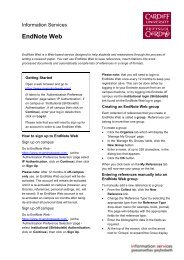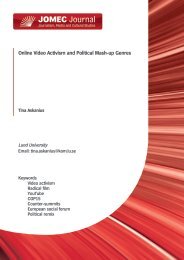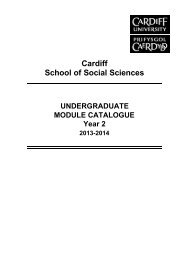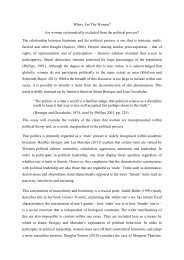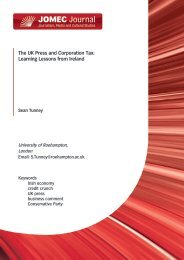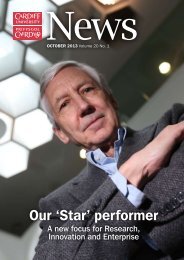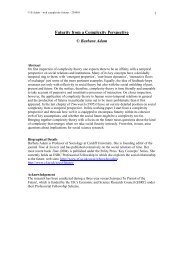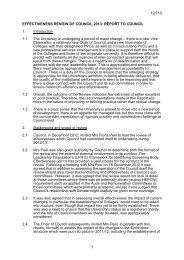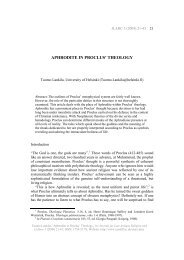Book Reviews - Cardiff University
Book Reviews - Cardiff University
Book Reviews - Cardiff University
You also want an ePaper? Increase the reach of your titles
YUMPU automatically turns print PDFs into web optimized ePapers that Google loves.
JLARC 7 (2013) 97-105<br />
97<br />
<strong>Book</strong> <strong>Reviews</strong><br />
Stephen R. L. Clark, Ancient Mediterranean Philosophy. An Introduction (London:<br />
Bloomsbury, 2013; xiv+245 pp. ISBN: 9781441123596. £16.99 (P).<br />
For a student who had to work his way through “traditional” textbooks on “Ancient Philosophy”<br />
and for whom, in the context of a Philosophy curriculum, “Ancient Philosophy”<br />
was equivalent to “Ancient Greek”, or more precisely, “Classical and Hellenistic Greek<br />
Philosophy” (with Plato, Aristotle, and “the Stoics” at the core, and a little bit of Cicero<br />
added on), the present volume offers a refreshing alternative. One could even call it an<br />
alternative history of Ancient Philosophy, or Ancient Mediterranean Philosophy, as the<br />
title aptly specifies. “Mediterranean” here stands for the cultural sphere which unites,<br />
historically and geographically, all the different influences that make up this “Western”<br />
phenomenon (as opposed, for example, to comparable phenomena in ancient South or<br />
East Asia). This is illustrated in the most fascinating way by a map (prepared by Stephen<br />
Ramsay and printed on p. xiii), which shows the Mediterranean not in the usual way with<br />
the west on the left and the east on the right, and a clear boundary between sea and land.<br />
Rather, on this map the east is on the top of the page and the west at the bottom, and the<br />
boundary between sea and land is merely indicated by a thin black line, while the actual<br />
boundary, which catches the eye and is indicated by a change in background-colour, runs<br />
between coastal land and low-lying plains, and “hinterland” of more than 200 m altitude.<br />
The sea and these low-lying areas are kept in white, the less accessible higher areas are<br />
shown in grey. These features illustrate far more compellingly than conventional maps<br />
the geographical factors that determine the importance of landscapes like Egypt, Cyrene,<br />
Libya and Numidia, the coastal lands of Italy, Sicily, the many islands, southern Gaul and<br />
the Iberian peninsula, and the proximity of places such as Elea and Syracuse, Miletus and<br />
Athens, Alexandria and Cyrene, Jerusalem and Heliopolis.<br />
Not that traditional approaches to Ancient Philosophy had not shown any awareness<br />
of the fact that “the Greeks did not invent philosophy” (p. x), but they did seem to rely on<br />
the assumption that only Classical and Hellenistic Greek philosophy (with its scientificrationalist<br />
tendencies) ultimately deserved the label, while everything outside that frame,<br />
be it earlier (in the “archaic” period) or later (in Late Antiquity), or geographically (and,<br />
moreover, linguistically!) outside the Graeco-Roman sphere (such as Egyptian, Semitic,<br />
Celtic, Persian and other traditions) was either a rudimentary or a decaying form of that<br />
“real thing”, especially when it did not keep to a narrowly rationalist stance but engaged<br />
in metaphysical speculation or religious ritual. Of course, as Clark points out (p. x, and<br />
see also p. 218f.), already many decades ago scholars such as Martin Bernal, Martin West<br />
and Thomas McEvilley demonstrated the strong dependence of Greek thought on African<br />
(Egyptian) and “Oriental” influences, but the controversies which some of these studies<br />
triggered, and which in some areas continue to this day, just underline the challenge that<br />
remains even today.<br />
Stephen Clark is in an excellent position to take on this challenge. In his studies on<br />
Aristotle, Plotinus and on ancient philosophical anthropology and theology more widely<br />
he has for many years contributed to a widening of the view of what can or what should<br />
be considered ancient philosophy. This book offers to some extent a synthesis of these<br />
efforts and a more comprehensive overview of a broad range of themes and historical<br />
developments. Obviously, an introduction can only do so much. In many areas it may<br />
<strong>Book</strong> <strong>Reviews</strong> in: Journal for Late Antique Religion and Culture 7 (2013) 97-105;<br />
ISSN: 1754-517X; Website: http://www.cardiff.ac.uk/clarc/jlarc
JLARC 7 (2013) 97-105<br />
98<br />
only scratch the surface of what may in each case be a whole research area, open to a<br />
wide range of interdisciplinary possibilities (for example with Archaeology, Oriental<br />
Studies, Semitic Studies etc.), but the merit of this book is that these strings are held<br />
together in an attempt to outline possibilities and opportunities which they may provide,<br />
and also point to their deeper significance and anthropologically and theologically more<br />
relevant dimensions.<br />
The book is divided into ten chapters. The first chapter, “Beginnings”, covers more or<br />
less the same ground which in traditional parlance is known as “Pre-Socratic Philosophy”.<br />
But Clark questions the traditional narrative which tends to depict this as a movement<br />
from “mythos to logos”, from a pre-rational to a rational approach to reality. The world<br />
into which the pre-socratic philosophers were born (from, say, the seventh century BC<br />
onwards) was already an ancient world. There were ancient cultures which for several<br />
thousands of years had tried to provide rational explanations for phenomena such as, for<br />
example, marine fossil finds in alpine rock formations (pp. 1-2). The fact that many of<br />
these explanations combined (Clark: “confounded”) down-to-earth reasoning with otherworldly<br />
fascination (note p. 19 the point that the Greek word for “god”, theos, originally<br />
meant “amazing”) does not per se make them less rational than say, the hyper-rationalist<br />
explanations (and applications) of some Hellenistic thinkers. “Even if Hippocrates of Cos<br />
(c450-c375BC) or his disciples helped to define the healer’s art, we had better not use<br />
their medicines,” Clark writes (p. 21). Our knowledge of ancient knowledge is patchy to<br />
say the least, he adds. We do not know in what way, if at all, theories influenced practical<br />
developments. We have next to no accounts of practitioners. Still, the few extant accounts<br />
of theoreticians might help us to put our present-day “world of science” in perspective.<br />
Who knows which of our cherished beliefs in “scientific truths” (which seem so obvious<br />
to many of us today) may yet turn out to be “entirely wrong”, or which “past philosophers<br />
may really have been correct” (p. 22)?<br />
The second chapter (“Influence from outside”) considers this historical fact (namely that<br />
Greek philosophy, already from its outset, found itself in an ancient world) from a more<br />
historico-geographical angle. Greek myths contain elements of Mesopotamian epics which<br />
emerged more than a thousand years earlier, such as those of Atrahasis or Gilgamesh (p.<br />
24). These epics also influenced the oldest layers of the Hebrew Bible. Already ancient<br />
Greek accounts drew links between ancient cultural founder figures (Hammurabi, Moses,<br />
Minos) and acknowledged their indebtedness to Babylonian, Persian, Egyptian and even<br />
Scythian cultural and scientific achievements (writing, mathematics, astronomy, poetry,<br />
askesis and divination). But there were also Greek accounts which belittled the barbarian<br />
achievements and in the name of reason proposed counter-myths according to which the<br />
savage cultures had no choice but to form modern states in order to survive, or else to end<br />
up as colonised subjects of modern states. Clark suspects that such “rationalist” countermyths<br />
as formulated by a range of Greek thinkers (Clark cites a passage from Diodorus as<br />
an example), could be at least in part politically motivated (p. 54). Perhaps, Clark writes,<br />
“presently established powers found it convenient to suggest that there was no alternative<br />
to Leviathan, and that a ‘state-less’ society was a contradiction” (ibid.).<br />
Chapter Three (“Inspired Thinkers”) explores further the source of rational thinking,<br />
which is itself beyond reason and found in those who are divinely inspired. While some<br />
held (already in Antiquity) that man created gods in his own image, Clark points out that<br />
some of the most respected religions in Antiquity, among them the religion of the Jews<br />
and Zoroastrianism, “denied that God could be pictured” (p. 56). Divine knowledge was<br />
for those inspired by the divine, and even those had to empty and purify themselves and<br />
exceed the highest ethical and intellectual standards. The fact that in the case of Judaism<br />
<strong>Book</strong> <strong>Reviews</strong> in: Journal for Late Antique Religion and Culture 7 (2013) 97-105;<br />
ISSN: 1754-517X; Website: http://www.cardiff.ac.uk/clarc/jlarc
JLARC 7 (2013) 97-105<br />
99<br />
this experience shaped a whole culture and its legal and social structure led ancients to<br />
conclude “that the Jews were a ‘nation of philosophers’” (p. 79). But the phenomenon<br />
was shared across virtually all ancient religions and includes such diverse personages as<br />
Pythagoras, Heraclitus, Isaiah, Diogenes and Parmenides.<br />
Chapter Four (“Travellers and stay-at-homes”) contrasts those who as philosophers<br />
took up a nomadic way of life with those who “stayed at home”, in the service of their<br />
fatherland. Again, this leads to interesting connections: The Sophists as mercenaries of<br />
the truth, or whatever could be sold as such, Socrates and Plato as patriots; but Socrates<br />
was not above suspicion; for although he was a loyal resident citizen (and even soldier),<br />
he was also aspiring to a higher truth, which made his sophistries not just a nuisance, but<br />
a threat to Athenian self-delusion and literally intolerable to the harassed Athenians, who<br />
put Socrates on trial and condemned him to death. But prepared even for that eventuality<br />
Socrates, as recorded in Plato’s dialogue Phaedo, recommended the “practice of death”<br />
(p. 92) as a philosophical exercise, a way of purification to attain a higher state of being<br />
(and intellect). Towards the end of the chapter Clark once more draws a link between this<br />
exceptional attitude towards philosophy and the concept of purity in the Hebrew Bible as<br />
a necessary pre-condition of being close to God, as was the collective “call” of the people<br />
of Israel, the “philosopher-nation” mentioned earlier (pp. 97-101).<br />
The following three chapters enter that “conventional” ground of the study of ancient<br />
Greek philosophy referred to at the beginning of this review. “Divine Plato” (Chapter Five)<br />
briefly introduces the Dialogues and discusses the notion of Form and the problem of the<br />
“two worlds”. It ends with a section on politics. “The Aristotelian synthesis” (Chapter Six)<br />
moves on to Plato’s greatest pupil, “the master of them that know” (p. 125). Much space<br />
here is dedicated to Aristotle the naturalist, to the question of slavery, and to the issue of<br />
Aristotle’s legacy, especially in view of what it means to be a philosopher, in “practical”<br />
(scientific, intellectual, ethical, religious and social-political) terms. This leads straight on<br />
to Chapter Seven, “Living the philosophical life”, an account of the Hellenistic Schools,<br />
which in the spirit of the present book includes not only Stoics, Cynics and Epicureans,<br />
but also Hebrews, Zoroastrians and Buddhists.<br />
Chapter Eight, following the natural time-line, leads on to the Romans. It is entitled<br />
“Ordinary and supernatural lives” and begins with a discussion of the phenomenon that<br />
Romans worshipped abstract virtues as deities, such as Liberty, Faith, and Peace. Much<br />
of this chapter is devoted to a discussion of Cicero’s reserved scepticism in the light of<br />
his countrymen’s hands-on approach to religion in daily life, the widespread practice of<br />
divination and the link between religion (or superstition) and technology. This chapter is<br />
also covering the period when Christianity began to establish itself in Rome (during the<br />
second century AD) and to develop its doctrine of the incarnation of God’s eternal Son,<br />
or Word, as a special case of the above-mentioned proximity between God and humanity.<br />
As was mentioned earlier with a reference, for example, to Socrates, and as is reiterated<br />
here with a reference to Apollonius of Tyana, the idea of philosophers achieving divine<br />
status through acts of extreme self-denial was not alien to the intellectual culture of the<br />
day. But the Christian claim that Jesus, on account of the story of his life and death, was<br />
identical with the eternal God, went way over the top in the view of many and was met<br />
with the deepest suspicion. Significantly, the question as to the exact nature of that claim<br />
was highly controversial among the Christians themselves, for centuries to come.<br />
Chapter Nine moves on to “Late Antiquity”. Clark here begins with a brief reflection<br />
on the traditional view that this period was obsessed with Fate and its “management”, for<br />
example, through astrology. He believes that this view was exaggerated and he introduces<br />
a number of cases, Plotinus among them, who argued against the Fatalism of astrological<br />
<strong>Book</strong> <strong>Reviews</strong> in: Journal for Late Antique Religion and Culture 7 (2013) 97-105;<br />
ISSN: 1754-517X; Website: http://www.cardiff.ac.uk/clarc/jlarc
JLARC 7 (2013) 97-105<br />
100<br />
practices. Still, late-antique philosophy lost some of its clarity and brevity and became<br />
cluttered with all manner of knowledge and wisdom accrued through many centuries of<br />
learning and from many cultures. Clark considers Oswald Spengler’s view that alongside<br />
Classical culture there existed in the late-antique Mediterranean a “Magian” intellectual<br />
culture which introduced emotional, communal and ritual elements into the essentially<br />
rationalist Classical philosophical tradition and thus developed it into a religion. Clark<br />
poses the question whether this pagan philosophical tradition might have been a more<br />
tolerant alternative to the ultimately victorious Christian Orthodoxy, or later, to Islam.<br />
To some extent an answer to this question is given in Chapter Ten, “An end and a<br />
beginning”. Ancient Mediterranean Philosophy was not extinguished, but persisted, if<br />
only as a largely “hidden”, subtle, sublime, phenomenon. Jan Assmann recently coined<br />
for it the phrase religio duplex, a second, subliminal, layer of religion beneath popular<br />
beliefs and practices, the “religion” of those few in every given age who “know” that<br />
popular religion cannot provide final answers and that any belief to be in possession of<br />
the ultimate truth can be no adequate substitute for the honest and persistent pursuit of<br />
truth, the “love of wisdom” (which is the meaning of philosophy), which will never be<br />
complete in this life. Clark shows that in this respect philosophy has probably never held<br />
a dominant position in any society and he poignantly hints at the similarity of the rhetoric<br />
used by a modern scientist, who declares all previous worldviews erroneous and obsolete,<br />
with that of an early Christian Church Father, who presents his own doctrine as a victory<br />
of the enlightenment over the illusions and fantasies of a benighted past.<br />
This relatively brief summary cannot do justice to the rich content of this book, be it<br />
the amount of historical material covered, or the level of philosophical investigation into<br />
individual questions. A brief section recommends further reading (pp. 217-219), and an<br />
extensive bibliography and index of names and subjects conclude the volume.<br />
Ancient Mediterranean Philosophy is a fascinating and highly instructive book, which<br />
can be recommended to any reader at any level, who not only wants to “know about” the<br />
history of philosophy in Antiquity, but in the process of learning about it would also like<br />
to learn how to practise philosophy in their own lives.<br />
Josef Lössl, <strong>Cardiff</strong> <strong>University</strong> (LosslJ@cardiff.ac.uk)<br />
Jörg Trelenberg, Tatianos. Oratio ad Graecos. Rede an die Griechen (Tübingen:<br />
Mohr Siebeck, 2012); x + 308 pp.<br />
The present volume is the most substantial treatment of Tatian’s Oratio ad Graecos for<br />
some time. It offers a newly edited Greek text with an annotated translation (pp. 84-193)<br />
and introductory chapters on the following topics: 1) The author (pp. 1-8), 2) Date and<br />
place of origin (pp. 8-15), 3) The transmission of the work (pp. 15-24), 4) Its Structure<br />
(pp. 25-29), 5) Its Theology (including Creation, Logos speculation, Pneumatology, Demonology,<br />
Anthropology and Ethics, pp. 29-54), 6) Its merits as an Apology (including<br />
polemics against philosophy, mythology and astrology, and defence of the concept of a<br />
“Barbarian Philosophy”, pp. 54-71). In addition there are five appendices: 1) Was Tatian<br />
a pupil of Justin Martyr (pp. 195-203)? 2) Was he a Gnostic (pp. 204-219)? 3) Why is the<br />
name of Christ not mentioned in the work (pp. 219-224)? 4) Who were the addressees of<br />
the work (pp. 224-230)? And 5) What is the genre of the work (pp. 230-240)? The book<br />
concludes with a bibliography and indices of biblical, classical and patristic references,<br />
names and Greek words, ancient and modern authors, and subjects.<br />
<strong>Book</strong> <strong>Reviews</strong> in: Journal for Late Antique Religion and Culture 7 (2013) 97-105;<br />
ISSN: 1754-517X; Website: http://www.cardiff.ac.uk/clarc/jlarc
JLARC 7 (2013) 97-105<br />
101<br />
One of the most noteworthy features of the work is the new critical text: Trelenberg’s<br />
aim is to restore it to a more pristine condition, closer to the manuscript tradition, after it<br />
experienced a radical makeover by Miroslav Marcovich’s critical edition of 1995, which<br />
contains more than 300 additional conjectures. But Trelenberg also rejects a number of<br />
earlier conjectures found in Eduard Schwartz’s edition of 1888, some of them by Ulrich<br />
von Wilamowitz-Möllendorf and Robert Münzel, and some made by yet earlier editors.<br />
This strategy has its merits, but also its limitations, as some examples may illustrate. It<br />
also happens in a context. Already Aimé Puech, Edgar Goodspeed and Molly Whittaker,<br />
in 1903, 1914 and 1982, produced editions (or translations based on readings) which did<br />
not accept Schwartz’s philologically refined text but preferred manuscript readings and<br />
lectio difficilior. They all relied on Schwartz, though. Schwartz’s work was a pioneering<br />
achievement made possible in turn by a study of Adolf Harnack’s published in 1882 on<br />
the manuscript tradition. This had established that all extant manuscripts originate from<br />
one 10 th c. manuscript, now lost, after the quires containing the text were removed at an<br />
early stage from the relevant codex, Paris, BnF, ms. gr. 451, the so-called codex Arethas.<br />
The extent to which the extant text of Tatian’s Ad Graecos could be improved with the<br />
help of manuscript readings was therefore rather limited. This had made Harnack very<br />
cautious. In a translation of the text based on von Otto’s edition of 1851, published in<br />
1884, Harnack included text-critical notes which did not allow for a single conjecture.<br />
Trelenberg (p. 21, n. 108) is quite correct when he speaks of Harnack’s “valuable (partly<br />
ingenious) text-critical observations”. The emphasis here is on the word “observations”,<br />
as opposed to “interventions”. Harnack rejected those. In contrast, Schwartz, Wilamowitz<br />
and Münzel felt that the text could be significantly improved by some bold, philologically<br />
informed conjectures, and a century later Marcovich escalated this approach by making<br />
on average five additional changes on every page, one in every 20 th word or phrase, thus<br />
in effect re-writing whole swaths of the work.<br />
Against this trend Puech, Goodspeed and Whittaker followed the tradition of von Otto<br />
and Harnack, and they are now joined by Trelenberg, who states his editorial principles as<br />
follows (p. 21): “The manuscript readings are, wherever possible and tolerable, preferred<br />
to speculation. Moderate conjecture is used in unambiguous cases of textual corruption<br />
[italics are Trelenberg’s]. Lectio difficilior is not shunned, though exaggerations – as by<br />
Kukula – are avoided.” The reference here is to Richard Kukula’s German translation of<br />
1913, which was very influential, but eccentric in places. But, as the following examples<br />
might illustrate, Trelenberg also adds his own touch. There are some significant changes<br />
compared to, say, Whittaker; and in some cases he even agrees with conjectures made by<br />
Marcovich. (Abbreviations used are of the three main manuscript witnesses: P = Paris,<br />
BnF, ms. gr. 174 (s. xi/xii); M = Modena, BE, GRE. 126 (s. xi); V = Venice, BnM, cod.<br />
gr. z. 343 (s. xi). Tatian’s Ad Graecos is abbreviated “or.”):<br />
Or. 1.1: ὦ ἄνδρες Ἕλληνες P, V, Trelenberg; ἄνδρες Ἕλληνες Whittaker. This is a tiny<br />
detail, but symptomatic. The omission of ὦ is the more difficult reading and backed by M,<br />
which many editors consider the best witness, which explains Whittaker’s choice. But<br />
Trelenberg follows P, V, and most earlier editions.<br />
Or. 1.4: σύµφυρτον ὑµῶν πεποιήκατε τὴν διάλεκτον Marcovich, Trelenberg; literally,<br />
“you have made your speech confused/messy” (scil. by importing foreign expressions).<br />
Here P, M and V read συµφύρδην, as do Schwartz and Whittaker, i. e. exponents of both<br />
“camps” of modern editors. Before Marcovich suggested σύµφυρτον, only von Otto had<br />
come up with any emendation at all, συµφύρτην. But no emendation is needed here. Both<br />
readings of the adjective, σύµφυρδος and σύµφυρτος, are attested in ancient literature. The<br />
ending too is correct; ἡ διάλεκτος is feminine. Marcovich’s intervention is gratuitous, al-<br />
<strong>Book</strong> <strong>Reviews</strong> in: Journal for Late Antique Religion and Culture 7 (2013) 97-105;<br />
ISSN: 1754-517X; Website: http://www.cardiff.ac.uk/clarc/jlarc
JLARC 7 (2013) 97-105<br />
102<br />
beit typical. It is the fact that Trelenberg follows Marcovich in this instance which comes as<br />
a surprise. It goes against his declared editorial strategy.<br />
Or. 7.4: Καὶ ἐπειδή τινι φρονιµωτέρῳ ... συνεξηκολούθησαν καὶ θεὸν ἀνέδειξαν ... οἱ<br />
ἄνθρωποι καὶ ἄγγελοι τὸν ἐπανιστάµενον τῷ νόµῳ τοῦ θεοῦ... “But when men and angels<br />
followed someone who was cleverer [scil. than the other celestial beings, because he was<br />
προτόγονος] and proclaimed him a god, although he had revolted against God’s law...”.<br />
The issue here is with ἄγγελοι, which is absent from the manuscripts. Schwartz inserted it<br />
to fill the apparent lacuna between καὶ and τόν, and later editors, including Whittaker and<br />
Trelenberg, were happy to follow him. This reading reinforces the impression of Tatian’s<br />
account of creation through the Logos as a kind of Gnostic myth, which Trelenberg shares<br />
(pp. 34-40), but which is problematic. 1 In an article published in 2005, not referenced by<br />
Trelenberg, Heinz-Günther Nesselrath suggested that Schwartz’s insertion of ἄγγελοι might<br />
be quite unnecessary if we read καὶ τὸν as καί τοι, “although”. 2 This is a possibility which<br />
points beyond Trelenberg’s text.<br />
Or. 7.5: ...διὰ δὲ τὴν παράβασιν καὶ τὴν ἄνοιαν ὁ πρωτόγονος δαίµων ἀποδείκνυται.<br />
“Because of his transgression and his madness the Firstborn was appointed [or ‘shown to<br />
be’] a demon.” Here Trelenberg, following a conjecture by von Otto, reads ἄνοια, “folly,<br />
madness”, but P, M and V read ἄγνοια, “ignorance, stupidity”. According to Trelenberg’s<br />
stated editorial strategy there should be no reason not to follow the manuscripts here.<br />
Or. 9.5: ...εἶτα πῶς πρὶν τούτους περὶ τὰς προειρηµένας τάξεις γενέσθαι ἀκόσµητος ἦν<br />
ὁ οὐρανός; “How’s that, then? Was the sky without ornaments before these [scil. the constellations]<br />
emerged around the predestined places?” Τάξεις, here “places”, was suggested<br />
by Wilamowitz and endorsed by Trelenberg (as it had been by Whittaker). P, M and V<br />
read πράξεις, “deeds”, which also makes sense; for in this passage Tatian ridicules the<br />
idea that the stellar constellations are manifestations of ancient myths, “deeds” committed<br />
by specific gods and men. In this case περὶ could be translated as “with regard to” or “in<br />
relation to”, so that the sentence could be translated: “…Was the sky without ornaments<br />
before these [constellations] emerged in relation to the aforementioned deeds?”<br />
Or. 27.2: Διαγόρας ἄθεος ἦν Kukula, Trelenberg; Διαγόρας Ἀθηναῖος ἦν P, M, V. In<br />
this case it is possible that ἄθεος is the original reading and that ἀθηναῖος is the result of a<br />
copyist’s error. (The word ἀθηναίοις occurs on the next line.) Ἄθεος makes better sense,<br />
since Tatian continues to say that Diagoras poked fun at the Mysteries celebrated among<br />
the Athenians. It is generally known that this lead to the notorious trial against Diagoras<br />
for “Atheism”. But Tatian does not mention the trial, nor does he use the word ἄθεος in<br />
this technical sense anywhere else in Ad Graecos. The assumption that ἄθεος is the most<br />
authentic reading here is pure conjecture. Significantly, Schwartz and Whittaker stick to<br />
Ἀθηναῖος. But the word has troubled others; for Diagoras was of course not an Athenian,<br />
but a Melian. Friedrich Jacoby therefore suggested the reading Μήλιος for Ἀθηναῖος,<br />
while Marcovich, true to his editorial strategy, suggested Διαγόρας Ἀθηναῖος ἄθεος ἦν.<br />
Or. 31.2: Μάρτυρας δὲ οὐ τοὺς οἴκοι παραλήψοµαι, βοηθοῖς δὲ µᾶλλον Ἕλλησι καταχρήσοµαι.<br />
Τὸ µὲν γὰρ ἄγνωµον (ὅτι µηδὲ ὑφ᾽ ὑµῶν παραδεκτόν), τὸ δ᾽ἂν ἀποδεικνύηται<br />
θαυµαστόν, ὁπόταν ὑµῖν διὰ τῶν ὑµετέρων ὅπλων ἀντερείδων ἀνυπόπτους παρ᾽ ὑµῶν τοὺς<br />
έλέγχους παραλαµβάνω. For this passage, Trelenberg, following Schwartz, relies on the<br />
1 See Lössl, J., “Zwischen Christologie und Rhetorik. Zum Ausdruck ‘Kraft des Wortes’ (λόγου<br />
δύναµις) in Tatians Rede an die Griechen,“ in: Prostmeier, F., H. Lona (eds), Logos der Vernunft –<br />
2 See Nesselrath, H.-G., “Il testo di Taziano, Oratio ad Graecos, e due recenti edizioni,” in:<br />
Eikasmos 16 (2005), pp. 243-263 at pp. 248-250. The two editions to which Nesselrath refers are<br />
the critical edition of Marcovich (published in 1995) and the translation of Salvatore Di Cristina,<br />
Taziano il Siro. Discorso ai Greci (Rome, 1991).<br />
<strong>Book</strong> <strong>Reviews</strong> in: Journal for Late Antique Religion and Culture 7 (2013) 97-105;<br />
ISSN: 1754-517X; Website: http://www.cardiff.ac.uk/clarc/jlarc
JLARC 7 (2013) 97-105<br />
103<br />
indirect transmission of the text in Eusebius, praep. ev. 10.11.1-5, which deviates from P,<br />
M and V in many details. But he does not follow Schwartz, and Schwartz does not follow<br />
Eusebius, in every detail. Take, for example, the expression in brackets. Here Schwartz,<br />
following P, M and V, reads ἡµῶν instead of ὑµῶν. Trelenberg may have intended to do the<br />
same; for his translation reads, “weil nicht einmal bei uns beweiskräftig”; but his text reads<br />
ὑµῶν, not ἡµῶν. Thus his translation follows the manuscripts, like Schwartz in this case,<br />
but his text follows Eusebius, against Schwartz. There is obviously some mistake here; but<br />
one could ask beyond that, as Nesselrath has done, 3 whether it is at all necessary for this<br />
passage to resort to the Eusebius-tradition in order to “improve” the text of P, M and V. We<br />
can read χρήσοµαι instead of καταχρήσοµαι, παραδεκτέον instead of παραδεκτόν, ὅταν<br />
instead of ὁπόταν, and λαµβάνω instead of παραλαµβάνω. A translation following these<br />
variants (provided by P, M and V) could read as follows: “As witnesses I will not take<br />
any of our own people, but rather make use of the partisans of the Greeks; for the former<br />
would be unwise (since not acceptable even by ourselves), while it might strike as rather<br />
impressive if I withstood you with your own weapons and resorted to arguments which are<br />
above suspicion even among you.”<br />
Or. 34.3: διὰ Περικλύµενον Marcovich, Trelenberg; διὰ τὸ περικλύµενον P, M, V; διὰ<br />
τὸν Περικλύµενον Gesner (editio princeps), von Otto, Harnack, Schwartz, Whittaker. This<br />
may be a case of lectio difficilior against manuscripts. Clearly, the majority went with the<br />
latter, making a slight emendation, while Trelenberg, following Marcovich, went in the<br />
other direction. (There are several more such cases in cc. 32-36.)<br />
These few examples can only provide a glimpse of what is a most welcome and useful<br />
new edition. They suggest, however, that at least in some cases it may be worth comparing<br />
Trelenberg’s text with that of earlier editions, at least with Schwartz’s and Whittaker’s;<br />
for Trelenberg does occasionally make decisions that are not in line with his own editorial<br />
strategy and seem unnecessarily to depart from the manuscripts, or prefer a perhaps convenient<br />
but doubtful conjecture. One wonders whether it is an inevitable side-effect of the<br />
proliferation of critical editions (in this particular case) that ultimately none of them can<br />
be relied upon with certainty. A final verdict on this question will probably have to wait<br />
until the publication of the successor of Schwartz’s text by the Patristische Kommission,<br />
announced by Nesselrath. 4<br />
Just a few more notes on the introductory and thematic chapters: These too are of solid<br />
quality. But research is progressing fast and in many directions. It cannot be expected of a<br />
volume such as this to cover every possible angle in its treatment of the relevant sources.<br />
However, the omission of certain themes and topics has repercussions for the remaining<br />
material, and of this any reader should be aware. For example, there are no sections here<br />
on Tatian’s use of and engagement with the Bible, or on his rhetorical theory and method,<br />
or on the cultural-intellectual context in which these may have been conveyed. Tatian is<br />
believed to have stood in some kind of teaching tradition located in Rome. Justin Martyr<br />
is believed to have been a teacher of his, Rhodon one of his pupils. A discussion between<br />
Rhodon and Apelles, a pupil of Marcion, is recorded by Eusebius in his Church History.<br />
These things and many more are important to consider for the argument of Ad Graecos,<br />
but they lie beyond Trelenberg’s scope. Regarding the date and place of Ad Graecos, for<br />
example, Trelenberg merely records the different theories (Rome, Athens, “the East”) and<br />
is inclined towards “the East” and a late date, i. e. after 172 (p. 15), but then adds that this<br />
applies only to the “Endredaktion” of the work. He therefore implies that some parts of<br />
3 Nesselrath, “Il testo,” p. 254-255.<br />
4 Nesselrath, “Il testo,” p. 244.<br />
<strong>Book</strong> <strong>Reviews</strong> in: Journal for Late Antique Religion and Culture 7 (2013) 97-105;<br />
ISSN: 1754-517X; Website: http://www.cardiff.ac.uk/clarc/jlarc
JLARC 7 (2013) 97-105<br />
104<br />
Ad Graecos may well have originated in Rome and its theological context, but when he<br />
discusses the relevant parts, this is not always sufficiently taken into account. The simple<br />
personification of the notion of λόγου δύναµις (“word-power”), for example, as a “Wesen<br />
sui generis” (p. 36) does not do justice to the complexity of this concept in the context of<br />
both the Christian Theology of the time and of the Second Sophistic with its rich culture<br />
of rhetorical theorizing. Trelenberg’s personification leads to a simplification of Tatian’s<br />
thought which does not do justice to the level of his hermeneutical thinking, evident, for<br />
example, in the way he explains the interaction of semantic meaning and physical sound<br />
in the acts of speaking and listening (or. 5.5). There is a danger here of “mythologizing”<br />
something which evidently is not meant to be mythological. Tatian’s “power of the word”<br />
is not a separate being in addition to God and the Logos, as Trelenberg’s account seems<br />
to suggest, but a theological concept developed to explain the relationship between God<br />
and the Word in analogy to what we know about the way human language works.<br />
This tendency to read the theological parts of Ad Graecos mythologically is mirrored<br />
in the way heresiological accounts are taken at face value in the chapter dealing with the<br />
question whether Tatian was a Gnostic (pp. 204-219). There is a connection between the<br />
two observations that all that ancient heresiologists have to say about Tatian’s Gnosticism<br />
and other heresies is ultimately derived from Irenaeus and that all that Irenaeus says about<br />
Tatian in that regard can be evidenced from Ad Graecos. “There is nothing in Tatian that<br />
cannot also be found in any other Apologist,” Trelenberg concedes (p. 217). Still, “only a<br />
well-meaning interpretation will situate him within ecclesiastical orthodoxy; in individual<br />
cases he definitely strays outside this context” (p. 219). Trelenberg may just try to be fair<br />
here and provide a balanced account, but recent studies such as Naomi Koltun-Fromm’s 5<br />
have shown that the view that Tatian was a heretic, which includes the charge that he was<br />
a Gnostic, is entirely a construction. There is no balance to strike here. As Trelenberg’s<br />
own evidence shows, it begins with Irenaeus and ends with Arethas, author of the tenth<br />
century Scholia Arethae, who saw Tatian as a proto-Arian on account of or. 5.2, where<br />
the Logos is called the “work” (ἔργον) of the Father. The fact that Trelenberg (p. 37f.)<br />
“defends” Tatian against this charge, while he nevertheless feels “irritated” by Tatian’s<br />
use of the expression indicates how close he still is to that tradition and how much he is<br />
in danger of simply continuing the heresiological narrative instead of subjecting it to a<br />
thorough critique. Yet again, admittedly, to provide such a critique may not be the primary<br />
task of an introductory chapter in a volume such as this.<br />
Finally, some notes on the brief section dealing with the question of the genre of the<br />
work (pp. 230-240). On p. 15 Trelenberg rightly points out that Ad Graecos is composed<br />
of quite diverse elements (didactic, polemical, archival materials etc.), which originated<br />
over a longer period of time and were at some later point subjected to an “Endredaktion”.<br />
Tatian himself hints at this, when he speaks or. 37.2 of having begun to write that part of<br />
the work at an earlier stage and now taking it up again after abandoning it for some time,<br />
and or. 42.1 of having “arranged” (συνέταξα) his material rather than having written it in<br />
one go. On pp. 231-233, however, when he criticizes Kukula’s ideas regarding a possible<br />
school-context for an oral presentation of certain parts of the speech, Trelenberg seems to<br />
have forgotten his earlier observation and calls in question a possible school context on<br />
the ground that it is not at all certain that Tatian founded a school in “the East”. But if Ad<br />
Graecos contains earlier material as well, surely it could contain material which Tatian<br />
might have delivered at some point during his Roman period.<br />
5 Koltun-Fromm, N., “Re-Imagining Tatian: The Damaging Effects of Polemical Rhetoric,” in:<br />
Journal of Early Christian Studies 16 (2008), pp. 1-30.<br />
<strong>Book</strong> <strong>Reviews</strong> in: Journal for Late Antique Religion and Culture 7 (2013) 97-105;<br />
ISSN: 1754-517X; Website: http://www.cardiff.ac.uk/clarc/jlarc
JLARC 7 (2013) 97-105<br />
105<br />
Then the question regarding addressees: Were they “outsiders” or “insiders”? “Real”<br />
Greeks (i. e. “pagans”) Trelenberg asserts, “would hardly have listened to his [Tatian’s]<br />
tirades” (p. 233). But then he concedes (p. 237) that Ad Graecos is at least at some level a<br />
protreptic, which “by definition is directed towards outsiders (Aussenstehende)” (ibid.).<br />
The outsider-insider question is also raised with regard to Tatian himself, a convert in<br />
constant need of “self-assurance” (“Selbstvergewisserung”), for himself as well as for<br />
those close to him. (Οἴκοι is a term repeatedly used in that regard, or. 1.3; 31.2.) Again,<br />
according to recent studies it is problematic to draw a clear line between Christian and<br />
non-Christian identities during this period. Tatian’s oration reflects a context of cultural<br />
encounter and exchange. The struggle between Greek and Barbarian philosophy is one in<br />
which the author of Ad Graecos is familiar with both sides. He is crossing borders, and<br />
his work reflects this. For the same reason “Apology” and the other possible genres such<br />
as protreptic, polemic, apodeictic etc. should not be considered mutually exclusive. The<br />
expression “apology” was used in Antiquity for a literary genre, as was, by distinction, Ad<br />
Graecos, Πρὸς Ἕλληνας. But the ancient approach to rhetoric was pragmatic and guided<br />
by “communicative strategies”. Thus a work could well be at the same time an ἀπολογία,<br />
a λόγος πρὸς Ἕλληνας, and a προτρεπτικός, and even contain strong elements of ψόγος, a<br />
“speech of blame”. It all depended on the rhetorical strategy of the work, or different parts<br />
of the work, if the work was a composite, as is probably the case here, or on the author’s<br />
strategy of communicating with his audience.<br />
Once more, it cannot be expected from such brief introductory chapters exhaustively<br />
to explore all the relevant aspects of the topics that suggest themselves from the study of<br />
Tatian’s Ad Graecos. The above remarks are merely hints to outline possible avenues of<br />
further inquiry, which Trelenberg’s volume will hopefully encourage.<br />
To conclude, therefore, the merit of this volume is beyond doubt. It serves the study of<br />
Tatian’s Ad Graecos in so many respects and is warmly recommended to any student of<br />
early Christianity, the Second Sophistic, the second-century Greek Christian Apologists<br />
and related areas.<br />
A (thankfully brief, though probably incomplete) list of errata: p. 20, l. 20: Whittaker;<br />
p. 23, n. [1]: praep. ev. 10,11,6-35 (the correct reference is given on p. 19 n. 101); p. 23,<br />
n. [2]: The last number on the line should be 41; p. 83, l. 26: For 1517 read 1592; p. 139,<br />
n. 220: Read “A. E. Osborne, Discourse”; also on p. 258: A. E. Osborne and E. F. Osborn<br />
(“From Justin to Origen”) are two different authors; p. 244: Stählin; p. 258: Pilhofer, P.:<br />
Presbyteron Kreitton.<br />
Josef Lössl, <strong>Cardiff</strong> <strong>University</strong> (LosslJ@cardiff.ac.uk)<br />
<strong>Book</strong> <strong>Reviews</strong> in: Journal for Late Antique Religion and Culture 7 (2013) 97-105;<br />
ISSN: 1754-517X; Website: http://www.cardiff.ac.uk/clarc/jlarc



